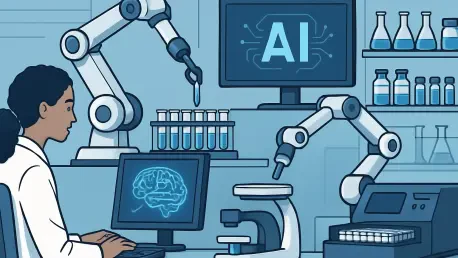The global laboratory automation market is undergoing a profound shift, propelled by the transformative power of artificial intelligence (AI) and cutting-edge technologies, with projections indicating a robust compound annual growth rate (CAGR) of approximately 7% through 2030, according to a detailed report by Medi-Tech Insights. This growth reflects an urgent demand for enhanced efficiency, precision, and scalability in laboratories worldwide, as they grapple with mounting pressures such as labor shortages and escalating healthcare costs. Automation, once a distant vision, has become a cornerstone of modern lab operations, leveraging robotics, software, and AI to handle repetitive tasks like sample preparation and data management. This evolution not only minimizes human error but also frees skilled professionals to focus on innovative research and critical decision-making. As the industry stands at this pivotal juncture, the integration of advanced tools promises to redefine workflows, offering a sustainable path forward for scientific and clinical advancements.
Revolutionizing Lab Workflows with AI and Machine Learning
The advent of AI and machine learning (ML) marks a significant leap in laboratory automation, moving far beyond mere mechanization to deliver intelligent, data-driven solutions. These technologies empower labs with predictive analytics, enabling the prioritization of samples and enhancing quality control mechanisms. By streamlining workflows, AI ensures that resources are allocated efficiently, drastically reducing turnaround times for critical tasks in diagnostics and research. This capability is particularly vital in high-pressure environments where speed and accuracy are non-negotiable. The ability of AI systems to adapt and optimize processes in real-time offers labs a competitive edge, ensuring they can meet growing demands without compromising on quality. As a result, the adoption of such technologies is becoming a benchmark for forward-thinking laboratories aiming to stay ahead in an increasingly complex landscape.
Moreover, AI’s role in enhancing decision-making capabilities within labs cannot be overstated, as it processes vast datasets to reveal insights that manual methods often overlook. This analytical prowess allows scientists to shift their focus from routine chores to groundbreaking discoveries, fostering innovation across various fields. Advanced tools, such as Siemens Healthineers’ Atellica CI Analyzer, exemplify how AI can integrate clinical testing with automation to address pressing challenges like staffing shortages. By automating complex processes and providing actionable intelligence, these systems enable lab personnel to make informed choices swiftly, improving overall operational outcomes. This shift toward smarter, AI-driven environments is not just a trend but a fundamental change in how laboratories approach problem-solving, positioning them to tackle intricate scientific questions with unprecedented precision and efficiency.
Technological Innovations Shaping the Market Landscape
Innovation remains the lifeblood of the laboratory automation sector, with companies continuously introducing advanced solutions to cater to diverse operational needs. Upcoming product launches, such as QIAGEN’s sample preparation instruments slated for 2026, and Inpeco’s FlexLab X system, unveiled in 2024, underscore a growing emphasis on flexibility and scalability. These tools are designed to accommodate labs of varying sizes, reducing reliance on manual labor while boosting throughput and consistency. Such advancements reflect a broader industry trend toward creating adaptable systems that can integrate seamlessly with existing infrastructures, addressing the unique challenges faced by modern laboratories. As these innovations roll out, they are expected to set new standards for efficiency, further accelerating market expansion.
Strategic partnerships also play a pivotal role in driving technological progress within this space, exemplified by the collaboration between ABB Robotics and Agilent Technologies in 2025. By merging robotics with analytical instruments, such alliances enhance precision and operational efficiency across industries like healthcare and pharmaceuticals. These collaborations are not merely transactional but represent a shared commitment to pushing the boundaries of what automation can achieve, setting benchmarks for quality and performance. The synergy created through these partnerships fosters an ecosystem of continuous improvement, where cutting-edge tools are developed to address specific pain points, such as labor-intensive processes or data inaccuracies. This collective push toward innovation ensures that laboratories remain equipped to handle evolving demands, reinforcing automation’s role as a critical enabler of scientific advancement.
Economic and Operational Advantages of Automation
One of the most compelling drivers behind the surge in laboratory automation is its ability to alleviate financial pressures faced by labs amid rising healthcare expenditures and persistent labor shortages. Automated systems offer a cost-effective alternative by minimizing the physical and mental strain on technicians, enabling sustainable operations even in understaffed settings. This economic benefit is particularly pronounced in clinical environments where the demand for rapid, reliable results often outpaces available human resources. By reducing operational costs and improving resource allocation, automation provides a viable solution for labs striving to maintain high standards under constrained budgets. This financial relief is a key factor fueling the widespread adoption of automated technologies across the sector.
Beyond cost savings, the transition from manual to automated processes significantly enhances productivity, a critical need in high-stakes fields like drug discovery and clinical diagnostics. Automation cuts down on downtime, allowing labs to manage larger workloads with greater stability and speed. This increased throughput ensures that labs can respond promptly to growing demands, delivering results that are both timely and accurate. The operational stability provided by automated systems also mitigates the risk of errors, a common challenge in manual workflows, thereby bolstering confidence in lab outputs. As laboratories continue to face escalating expectations for efficiency, the ability of automation to optimize performance without sacrificing quality stands out as a transformative advantage, shaping the future of scientific and medical progress.
Barriers to Widespread Adoption of Automation
Despite the clear benefits, the path to full automation in laboratories is fraught with challenges, particularly for small and medium-sized labs (SMLs) that often lack the resources of their larger counterparts. The complexity of operating sophisticated systems, coupled with a notable shortage of trained personnel, creates substantial obstacles to adoption. Additionally, the high initial and ongoing maintenance costs of automation solutions can be prohibitive for SMLs, deterring investment despite the long-term benefits. These financial and skill-related barriers highlight a disparity in access to technology, where smaller entities struggle to keep pace with industry advancements. Addressing these hurdles is essential to ensure that the advantages of automation are equitably distributed across all lab environments.
Another significant issue is the slow rate of adoption among smaller labs, driven by limited evidence of cost-effectiveness and an inherent reluctance to embrace risk. While large bio-pharma companies integrate automation seamlessly due to their scale and financial capacity, SMLs often hesitate, wary of the potential disruptions and uncertain returns. This hesitancy underscores the need for more accessible, user-friendly solutions tailored to the constraints of smaller operations. Furthermore, the development of comprehensive training programs to equip staff with the necessary expertise is crucial for overcoming resistance and building confidence in automated systems. Bridging this adoption gap requires a concerted effort from industry stakeholders to create affordable technologies and support structures that empower all labs, regardless of size, to leverage the transformative potential of automation.
Future Pathways for Laboratory Automation
Reflecting on the trajectory of the laboratory automation market, it’s evident that the strides made in recent years have laid a solid foundation for sustained growth through 2030. The seamless integration of AI and machine learning has redefined operational paradigms, offering labs the tools to achieve unparalleled precision and efficiency. Technological innovations and strategic collaborations have played a crucial role in addressing complex challenges, while economic benefits have helped labs navigate financial constraints. Even as barriers like skill gaps and high costs persist, the industry has demonstrated resilience, adapting to diverse needs across regions and lab sizes.
Looking ahead, the focus must shift to actionable strategies that democratize access to automation technologies. Developing cost-effective solutions tailored for smaller labs, alongside robust training initiatives, will be vital to closing the adoption gap. Industry leaders should prioritize partnerships that foster innovation and scalability, ensuring that automation continues to evolve as a cornerstone of scientific progress. By addressing these imperatives, the laboratory automation sector can build on its past achievements to create a future where every lab, regardless of scale, harnesses the full potential of advanced technologies for transformative impact.









